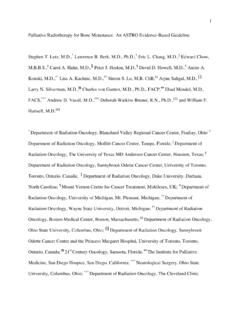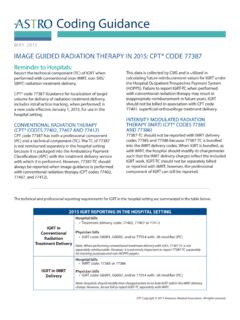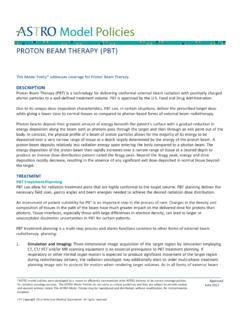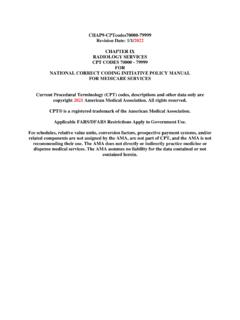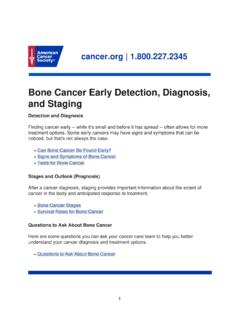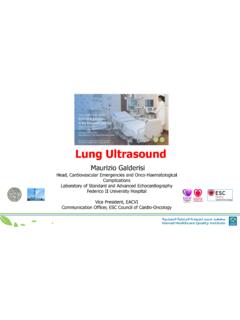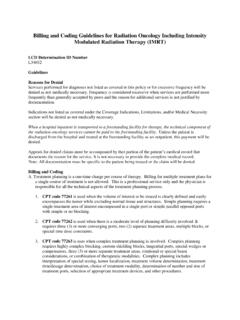Transcription of Medicare’s Physician Supervision Requirements
1 Medicare s Physician Supervision Requirements Updated May 2011 1 Medicare s Physician Supervision Requirements The Centers for Medicare and Medicaid Services or CMS (formerly known as the Health Care Financing Administration) is responsible for administering the Medicare program. Over the years, Medicare s policies related to Physician Supervision Requirements have been issued through regulations or through instructions to Medicare carriers in various manuals. The CMS policies on Physician Supervision Requirements that are pertinent to radiation oncologists are focused on five specific benefits to which Medicare beneficiaries are entitled by law (Title XVIII of the Social Security Act).
2 The five benefits, the statutory language and the section of the Social Security Act in which they appear are listed below. 1. Incident To Services in an Outpatient Hospital Setting (Section 1861(s)(2)(B)); 2. Radiation Therapy Services in an Office or Free Standing Radiation Therapy Center (Section 1861(s)(3)); 3. Diagnostic Tests in an Office or Free Standing Radiation Therapy Center (Section 1861(s)(3)); 4. Diagnostic Tests in an Outpatient Hospital Setting (Section 1861(s)(2)(C)); and 5. Incident To Services in an Office or Free Standing Radiation Therapy Center (Section 1861(s)(2)(A)).
3 In the following sections, the Supervision Requirements for these five benefit categories are summarized and the implications for radiation oncologists, who are the supervising physicians, are discussed. This document uses the term Physician throughout but the regulations also permit a non- Physician practitioner to provide Supervision . The service in question, however, must be within that individual s State scope of practice for which the individual has been granted privileges by the hospital to perform said service. This paper also includes a summary of the Federal laws and regulations as cited in the document.
4 1. Physician Supervision of Incident to Services in an Outpatient Hospital Setting Hospitals provide two distinct types of services to outpatients: services that are diagnostic in nature and other services that aid the Physician in the treatment of a patient. Therapeutic services are those services and supplies (including the use of hospital facilities) which are incident to the services of physicians in the treatment of patients. Such services include radiation therapy, clinic services and emergency room services. To be covered as incident to physicians services, the services and supplies must be furnished on a Physician s order by hospital personnel and under a Physician s Supervision .
5 A hospital service or supply would not be considered incident to a Physician s service if the attending Physician merely wrote an order for the services or supplies and referred the patient to the hospital without being involved in the management of that course of treatment. Medicare s Physician Supervision Requirements Updated May 2011 2 There is no requirement that the Physician who orders the hospital services be directly connected with the department that provides the services. Hospital outpatient therapeutic services furnished in the hospital or Critical Access Hospitals (CAHs) or in an outpatient department of the hospital or CAH, both on- and off-campus have a minimum requirement of direct Supervision .
6 In order to meet that direct Supervision requirement the supervising Physician or non- Physician practitioner must be immediately available, meaning physically present, interruptible and able to furnish assistance and direction throughout the performance of the procedure. It does not mean that the Physician or non- Physician practitioner must be present in the room when the procedure is performed. CMS removed the physical boundary requirement in the definition of direct Supervision in order to allow the supervising practitioner greater flexibility in location while still meeting the requirement to be immediately available.
7 CMS did not relax the requirement that, for direct Supervision , the supervisory Physician or non- Physician practitioner must be immediately available, meaning that the supervisory practitioner must be physically present and interruptible. They are not defining immediate availability in terms of time or distance. The new definition will now apply equally in the hospital or in on-campus or off-campus provider-based departments (PBDs). The supervising Physician or non- Physician practitioner must also be a person who is clinically appropriate to supervise the services or procedures. More specifically, the current CMS regulations ( (f)) state that the Physician or non- Physician practitioner must be available to furnish assistance and direction throughout the performance of the procedure.
8 This means that the Physician or non- Physician practitioner must be prepared to step in and perform the service, not just respond to an emergency. The supervising Physician does not necessarily need to be of the same specialty as the procedure or service that is being performed or from the same department as the ordering Physician . However, the supervisory Physician or non- Physician practitioner must have within his or her State scope of practice and hospital-granted privileges, the ability to perform the service or procedure. So for example, if radiation therapy services were being provided in a hospital outpatient department and the radiation oncologist who was supervising those therapeutic services left the hospital campus, a qualified Physician or Physician practitioner would need to be immediately available to supervise the procedures.
9 If there is no qualified supervising Physician immediately available, no radiation therapy services provided during his/her absence can be covered by Medicare. The services covered under this benefit also include materials and services of technicians. It is inappropriate to allow one Physician or non- Physician practitioner to supervise all services being provided in multiple PBDs. It would be highly unlikely that one Physician or non- Physician practitioner would be both immediately available at all times that therapeutic services are being provided and would have the knowledge and ability to adequately supervise all services being performed at once in multiple off-campus PBDs.
10 Medicare s Physician Supervision Requirements Updated May 2011 3 CMS has also designated a limited set of therapeutic services meeting specific criteria as nonsurgical extended duration therapeutic services, defined in 42 CFR (a)(1)(v). A table listing the current extended duration services can be found at: CMS includes such things as IV infusion or hospital observation care. They do NOT include radiation therapy services. In the provision of these services, CMS requires a minimum of direct Supervision during the initiation of the service, which may be followed by general Supervision for the remainder of the service at the discretion of the supervisory practitioner.

